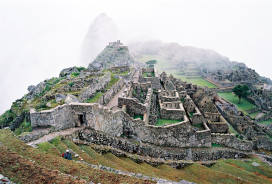|
Peru
Peru´s
past civilizations have forged a country culturally rich and intriguing.
There are colonial cities with a preserved
legacy of the Spanish conquistadors, and cities marked by the Inca culture
such as Cusco, the ancient capital of the Inca Empire. Nature has
also made the country very attractive and dramatic, with spectacular and varied scenery
featuring the Andes Cordillera, the Amazon Forest, coastal deserts,
vulcanoes and canyons. The indigenous population has its cultural space in
the country and still keep some ancient Inca traditions.
The
capital
The
metropolis Lima has a busy cultural life and a preserved historical center,
but also has the problems of a big city such as pollution and noise. A trip
to Lima must include visiting the huge squares in the center, the good
museums, the old buildings of the historical center, including the
monasteries
and enjoying the agitated night-life and the cafes.
Cusco
The
city is used by many travellers as the starting point of the Inca Trail and
Machu Picchu, but it's much more than that: Cusco has the most preserved
architecture and cultural traces of the two cultures that formed the
identity of Peru: the Inca and the Spanish. From the Inca, Cusco inherited urban ruins and foundations, apart from traditions kept until now.
From the Spanish, all the charm of a colonial period with streets, houses,
beautiful monasteries and churches that transport us to the past. Cusco is
definetly the most beautiful and interesting city in Peru, and one of the
most intriguing in South America.
Machu
Picchu
The
lost city of the Incas is one of the biggest attractions of South America.
The mystery, mysticism, archeology and adventure continously attract herds
of visitors to the ruins every year. Machu Picchu remained undiscovered,
covered by the jungle, for many centuries, due
to the amazing location where it was built, making the access difficult and
keeping the city a secret for centuries - the Spanish never knew of its
existence. It was only in 1911 that this historical complex was found.
The
world has since been marvelled by the advanced techniques of agriculture and
architecture that the Inca showed in the construction of the city, although
its real function and reason to exist remains a mystery.
The
Inca Trail- Trekking
The
Inca Trail is the most adventurous way to "discover" Machu Picchu
and one of the most popular trekkings of the Americas. It's a unique
experience in life, and offers a physical and psychological challenge.
The
stunning scenery formed by the Andes Cordillera, on a trail between 3.000 -
4100 metres above sea level, mixed with the myth of a civilization that lived there
500 years ago, contribute to the magic of the Inca Trail.
On
the way there are other important archeological sites to be visited. The end
of the trail culminates with the arrival to Machu Picchu and all its mystery
and beauty.
The
Inca Civilization
The
Incas were the most important people of the pre-Colombian America. Their
legacy to humanity was unmeasurable in many areas such architecture,
engineering, agriculture, goldsmith, pottery and others. They built palaces,
temples and cities of stones, and considered themselves to be the "Sons
of the Sun", and so studied the sky and the stars, becoming excellent
astronomers. All the ideology of life and religiosity of the Incas was based
on the elements of nature: mountains, rivers, lakes, valleys and animals
were worshipped and preserved, on the search for harmony between men and
nature. Almost 500 years after the massacre that ended the Inca Empire,
we still don't fully understand the cultural and technological legacy of
this civilization from the Andes.
The
South- Puno / Nazca /Arequipa
The
South of Peru has a good number of attractions, with varied landscape.
Puno
is a small city at an altitude of 3.855m, located on the margens of
Lake Titicaca, the highest navegable lake in the world. The main attractions
of this beautiful lake and the flotating islands of Uru. The islands are
built from a plant called "totora", and the inhabitants live on
them, in houses also made from the plant.
Arequipa
is close to the coast, but still in the Andes, in an altitude of over 2.000
meters. This geographic combination makes the scenery fantastic, with the
ocean, vulcanoes, desert, valleys, canyons and mountains all at a small
distance from each other. The city itself has a beautiful colonial
architecture and is built at the base of the vulcano El Misti. Arequipa is an
important cultural and touristic centre in Peru, and also the starting point
to visit one of the deepest canyons in the world: the Cañón del Colca,
with a depth of about 3.400 metres, where it's common to see the Condors,
giant birds with a wingspan of 3 meters.
On
the way to the canyon, it's possible to see the mountains where the spring
of the Amazon River is located.
Nazca
is located in a desert area, and has some interesting attractions: one of
the most important archeological sites of Peru, the Lines of Nazca, the
Cemetery of the Nazca civilization and Aqueducts from the ancient
civilization that inhabited the area. The Lines are geometrical shapes and
drawings, forming enormous animal and human figures, perfect triangles and
other shapes, best seeing from an airplane. The enygma that encircles the
Lines of Nazca are among the big mysteries of the world, intriguing
cientists and visitors.
The
North Coast
An
extremely varied scenery marks this area. The North coast has a coastal
desert, archeological Inca and pre-Inca sites, the pacific ocean,
cordilleras and vulcanoes such as the Huacarán. Popular activities include
surfing at the beaches, relaxing in the hot springs, trekking and climbing
in the National Parks in the Cordillera Branca, surrounded by mountains,
vulcanoes, lakes and ice-fields.
For packages and tours in Bolivia or for many other destination please
contact us.
      
|